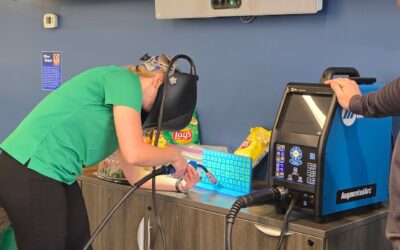1 in 4 Americans report they have no emergency fund at all, according to a 2021 survey by Bankrate.com. There are 45 million adults who have student loan debt. We can’t rely on our schools to teach our kids all they need to know about money. It is everyone’s job to teach children to save.
April is designated as Teach Children to Save Month. We’ve rounded up a list of educational activities you can use to teach your kids about money.
MONEY LESSONS FOR KIDS
Young Kids
- Sort Coins: Gather up the change in your house and let your kids help sort and count the coins. Younger kids will learn to recognize the difference between different types of coins. As they get older, let them practice their math skills and roll coin to take to the bank.
- Give Kids Cash: Headed to the ball diamond or the dollar store? End the arguments now by giving them a set amount to spend in an envelope. Seeing the cash will make it clear what they have to spend and teaches them how to make choices. And when the envelope is empty…hold your ground.
- Keep it Safe: Open a children’s savings account or use a piggy bank to teach them where they can safely keep their money.
- Earn It: We know the truth; money does NOT grow on trees. Help your child learn the value of a dollar by earning it. Create a simple chore chart of jobs with the pay for each, or download a free template online. Train your child to mark the jobs they complete and schedule payday every week.
- Visual Goals: We all do better when we have a visual to track our goals. Help your child make a poster to track their savings goal and hang it where they will see it every day. (This works great for adults too!)
Tweens and Teens
- Shopping Budget: Before you head out to the mall, set a budget for what your child can spend that day. Better yet, put the cash in an envelope and hand it to them. As the money gets spent, they’ll learn how to look for sales, use coupons, and choose between needs and wants.
- Skin in the Game: Does your teen want an expensive pair of shoes or the latest video game? Even if you can afford to buy it, make them help pay for it. They’ll think twice about what they want and learn to make hard choices about how they spend their money. The same goes for larger expenses such as cars and college.
- Learn How to Bank: As your child gets older, teach them to fill out a deposit slip, endorse a check for mobile deposit, and transfer money between accounts. Helping them learn how to manage bank accounts while they are still under your roof provides a safety net they may not have after graduation.
- Work for It: Understanding the value of a ‘hard-earned’ dollar gives your child perspective and more appreciation for money. Summer and part-time jobs not only teach our teens ‘money doesn’t come from trees’, but it also builds their work ethic and time management skills.
Young Adults
Financial lessons don’t stop when our children leave the house…
- Build Credit Carefully: A credit builder loan, often secured by a Certificate of Deposit, is a safe way to help your young adult build credit. Some credit card companies will also allow you to add your child as an Authorized Signer and report to the credit bureaus on their behalf. Don’t let the credit card company handing out free t-shirts be the one to teach your child about building credit.
- Monthly Budget: Creating a zero-based budget every month, helps anyone understand what money is coming in and going out. Creating the budget, tracking spending, and sticking to it will help them be financially secure and reach future goals.
- Compound Interest: One of the best lessons you can teach your adult child is to start saving as soon as possible. Take a look at this example to demonstrate the huge difference saving a few years earlier can make.
You don’t have to be a financial advisor or savvy saver yourself to teach your children to save. Financial literacy is a set of skills we accumulate throughout every season of our life. The more you talk about money with your kids, the better off they will be.


